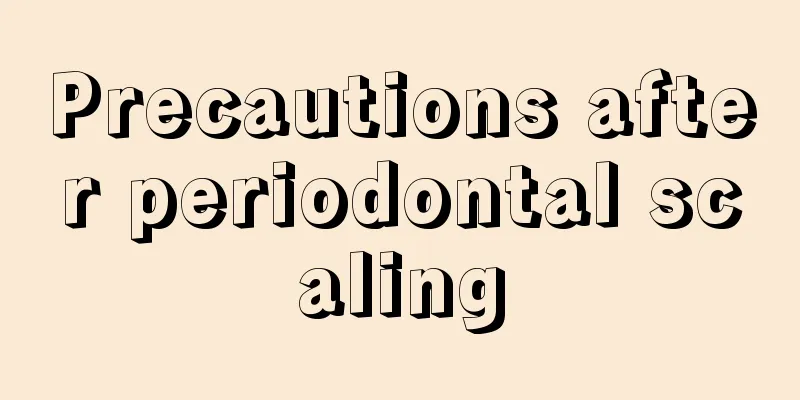Precautions after periodontal scaling

|
Periodontal scaling is treated by subgingival scaling. This deep teeth cleaning method can effectively remove dental plaque and has a very good effect on the treatment of periodontitis and gingivitis. Subgingival scaling is not very complicated, but considering that teeth are used frequently, we must pay attention to some details to avoid affecting our teeth. So, what are the precautions after periodontal scaling? Let’s take a look below. Subgingival scaling is a procedure that uses a relatively fine subgingival scaler to scrape away tartar and plaque on the root surface in the periodontal pocket. The main pathogenic factors of periodontitis are tartar and plaque attached to the surface of tooth roots. We usually use subgingival scaling, which is commonly known as "deep cleaning" to remove deep dental plaque. Root planing is the continuation and improvement of subgingival scaling. Because tartar plaque is widely distributed and invisible to the naked eye, it is impossible for doctors to completely remove it during clinical operations, and a certain amount of tartar is often missed. Therefore, after subgingival scaling, doctors use a fine subgingival scaler to sense and scrape away the diseased tissue and scattered tartar plaque on the root surface by hand, making the root surface smooth, which is conducive to the re-attachment of the gums to the root surface and the disappearance of periodontal pockets. Currently, periodontal pocket endoscopes can also be used to assist in the operation. Indications Gingivitis, periodontitis Scaling is the most basic treatment for various periodontal diseases, and subgingival scaling and root planing is one of the steps. Preventive treatment Regular cleaning is performed during periodontal maintenance to remove plaque and tartar in order to maintain periodontal health in the long term and prevent the occurrence and recurrence of periodontal diseases. Preparation for other oral treatments For those with more tartar, cleaning should be performed before taking the impression for restoration to eliminate gingival inflammation and facilitate the accurate production of the restoration. Some major oral surgeries require cleaning before they occur to eliminate the risk of infection and transient bacteremia. Cleaning is also required before and during orthodontic treatment to eliminate existing gingivitis or prevent the occurrence of gingivitis. Postoperative precautions ① If there is a lot of bleeding during subgingival curettage, antibiotics can be used appropriately to prevent infection or periodontal plugs can be applied locally for 4 to 6 days after the operation. ② Instruct patients to use the correct toothbrushing method, pay attention to oral hygiene, and follow up regularly in the outpatient clinic. |
<<: Thoracic vertebra hyperplasia causes back pain
>>: Manifestations of male chauvinism
Recommend
Endometrial cancer first stage cure
The effectiveness of uterine cancer treatment is ...
The main characteristics of coelenterates
Coelenterates belong to the phylum Cnidaria. It w...
I feel like vomiting after drinking coffee
It is well known that drinking coffee has a refre...
What symptoms should we pay attention to for prostate cancer and how to prevent prostate cancer
Patients with prostate cancer must pay attention ...
Treatment methods and dietary principles for breast fibroids
Breast fibroma is a common gynecological disease ...
What are the benefits of skipping rope for pregnancy preparation?
When it comes to preparing for pregnancy, many co...
How to treat early bone cancer
How to treat bone cancer in its early stages? The...
The efficacy and function of Tibetan medicine foot bath
Tibetan medicine is a kind of medicine. It is not...
What to do if your child hits his head and gets a bump
In daily life, some minor bumps and bruises are i...
What to eat when your mouth tastes bland
We all know that the human taste organs are very ...
How to choose therapeutic drugs for osteosarcoma
Osteosarcoma usually occurs in adolescents under ...
Pu'er tea storage humidity and temperature
The storage conditions for tea are actually very ...
How to exercise the frontal lobe of the brain
The prefrontal lobe of the brain plays a very imp...
Is uterine cancer hereditary?
Inheritance, will endometrial cancer occur in pat...
Surgical treatment of lung cancer
The role of surgical treatment for lung cancer at...









